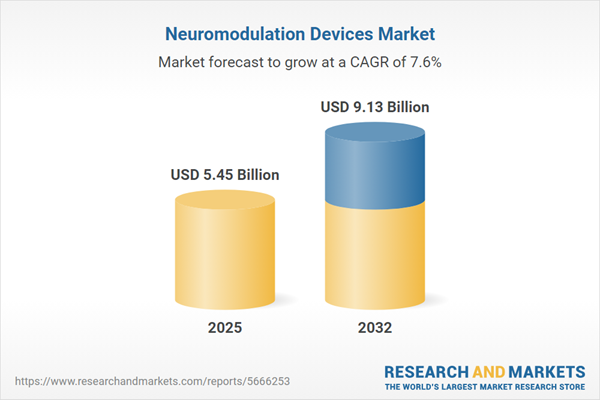Speak directly to the analyst to clarify any post sales queries you may have.
Neuromodulation devices are transforming therapeutic protocols by offering precision-targeted solutions for complex neurological and psychiatric conditions. Senior leaders rely on actionable insights from this market to guide investments and strategic partnerships within advanced healthcare technology.
Market Snapshot: Neuromodulation Devices Market
The Neuromodulation Devices Market grew from USD 5.08 billion in 2024 to USD 5.45 billion in 2025. The sector is forecasted to expand at a compound annual growth rate (CAGR) of 7.59% through 2032, reaching USD 9.13 billion. Market momentum is driven by escalating prevalence of chronic neurological and psychiatric conditions, coupled with evolving reimbursement models that promote advanced, nonpharmacological, and adjunctive treatments.
Scope & Segmentation
- Device Types: Invasive devices (deep brain stimulators, sacral nerve stimulators, spinal cord stimulators, vagus nerve stimulators) and noninvasive devices (transcranial direct current stimulation, transcranial magnetic stimulation)
- Control Mechanisms: Closed loop devices and open loop devices, catering to both adaptive and fixed stimulation protocols
- Technologies: Electrical stimulation, magnetic stimulation, optogenetic stimulation, ultrasonic stimulation
- Age Groups: Adult, geriatric, and pediatric patient populations, reflecting anatomical and clinical diversity
- Therapeutic Areas: Gastrointestinal and urological disorders, neurological disorders (dystonia, epilepsy, Parkinson’s disease), pain management (chronic and neuropathic pain), and psychiatric disorders (depression, obsessive-compulsive disorder)
- End Users: Ambulatory surgical centers, clinics, hospitals, and research institutes adopting personalized neuromodulation solutions
- Distribution Channels: Offline medical equipment suppliers and online ordering platforms with remote support
- Regional Coverage: Americas (United States, Canada, Mexico, Brazil, Argentina, Chile, Colombia, Peru), Europe, Middle East & Africa (United Kingdom, Germany, France, Russia, Italy, Spain, Netherlands, Sweden, Poland, Switzerland, United Arab Emirates, Saudi Arabia, Qatar, Turkey, Israel, South Africa, Nigeria, Egypt, Kenya), Asia-Pacific (China, India, Japan, Australia, South Korea, Indonesia, Thailand, Malaysia, Singapore, Taiwan)
- Company Analysis: Leading manufacturers and innovators including Abbott Laboratories, Boston Scientific Corporation, Medtronic plc, LivaNova PLC, Saluda Medical Pty Ltd, and relevant startups, profiling competitive dynamics
Key Takeaways for Senior Decision-Makers
- Neuromodulation systems leverage advanced platform miniaturization and adaptive control, enabling precise neural circuit intervention and improved patient outcomes.
- Adoption is shifting from last-resort therapies to earlier interventions, prompted by expanded clinical validation and integration with digital health ecosystems.
- Collaboration among device manufacturers, clinicians, and research institutions fuels rapid advancement, enhancing both implantable and external device performance.
- Value-based care trends are accelerating payer recognition of neuromodulation’s long-term economic and clinical benefits in reducing reliance on conventional pharmaceuticals.
- Customized devices, ergonomic enhancements, and diverse therapeutic protocols drive segment-specific growth, accommodating varying patient demographics and clinical needs.
- Innovative components, such as sensor technologies and remote monitoring tools, are central to differentiation and adoption among healthcare providers.
Tariff Impact on Neuromodulation Device Supply Chains
Upcoming U.S. tariffs targeting microelectronics and specialty components central to neuromodulation systems present critical supply chain challenges. Manufacturers are recalibrating sourcing strategies through local partnerships, nearshore production, and vertical integration to balance cost management with operational resilience. Companies are concurrently redesigning components and investing in alternative materials to mitigate impact. These adaptations will shape cost structures and long-term competitiveness as trade policies evolve.
Methodology & Data Sources
This report is grounded in comprehensive secondary research—covering clinical trial registries, patent databases, and global regulatory filings—combined with primary interviews with clinicians, biomedical engineers, and procurement specialists. Quantitative findings are corroborated through sales data and device registries, while scenario modeling assesses risk factors and supply dynamics. Quality controls ensure analytical rigor and ethical compliance.
Why This Report Matters
- Senior executives gain actionable insights for reshaping R&D and market strategies in an environment shaped by clinical, regulatory, and operational shifts.
- The report offers a holistic segmentation analysis, supporting tailored go-to-market strategies that align with emerging technologies and patient groups.
- Detailed regional and company profiles inform optimal investment, partnership, and supply chain decisions to bolster growth and operational agility.
Conclusion
Neuromodulation device innovation is redefining clinical practice through multidisciplinary collaboration and patient-centered advancements. Future market leadership will be shaped by agility, strategic partnerships, and ongoing commitment to evidence-driven development. This in-depth analysis will guide executive decisions in a rapidly evolving global ecosystem.
Additional Product Information:
- Purchase of this report includes 1 year online access with quarterly updates.
- This report can be updated on request. Please contact our Customer Experience team using the Ask a Question widget on our website.
Table of Contents
3. Executive Summary
4. Market Overview
7. Cumulative Impact of Artificial Intelligence 2025
Companies Mentioned
The companies profiled in this Neuromodulation Devices market report include:- Abbott Laboratories
- Aleva Neurotherapeutics SA
- Biotronik SE & Co. KG
- Boston Scientific Corporation
- BrainsWay Ltd.
- ElectroCore, Inc.
- Integer Holdings Corporation
- Laborie
- Life Science Outsourcing, Inc.
- LivaNova PLC
- Medtronic plc
- Neuromod Devices Limited
- Neuronetics, Inc.
- Neuropace Inc.
- NeuroSigma, Inc.
- Nexstim Oyj
- Saluda Medical Pty Ltd
- Soterix Medical Inc.
- Synapse Biomedical Inc.
- Synergia Medical SA
- tVNS Technologies GmbH
Table Information
| Report Attribute | Details |
|---|---|
| No. of Pages | 185 |
| Published | November 2025 |
| Forecast Period | 2025 - 2032 |
| Estimated Market Value ( USD | $ 5.45 Billion |
| Forecasted Market Value ( USD | $ 9.13 Billion |
| Compound Annual Growth Rate | 7.5% |
| Regions Covered | Global |
| No. of Companies Mentioned | 22 |









